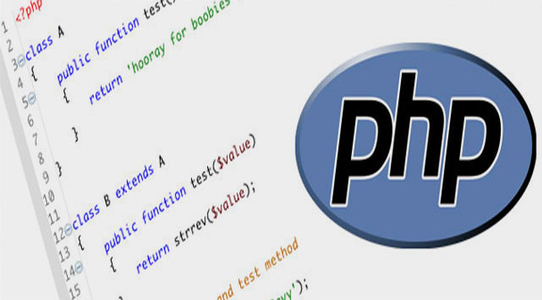10 recommended courses on file pointers
Advanced application of PHP file processing - file pointer PHP can realize the positioning and query of file pointers, thereby realizing fast query of required information. The file pointer functions include rewind(), fseek(), feof() and ftell() function. In the previous article "Advanced Application of PHP File Processing—Remote File Access and Locking Files" we introduced remote access to files and how to lock files. Friends who haven't read it can go and take a look. I won't cover it here. Enough talk, today we mainly talk about the functions in the file pointer! 1: rewind() function This function sets the pointer of the file handle to the beginning of the file stream. The syntax format of this function is as follows: bool rewind (resource $handle) Note: If the file is opened in append ("a") mode, then Any data written to a file will always be appended to the end of the existing contents of the file, regardless of the position of the file pointer! 2: fseek() function The fseek() function realizes the positioning of the file pointer. The syntax format of this function is as follows:
1. What is a PHP lock file? Summarize the usage of locked file examples

##Introduction: Advanced application of PHP file processing - file pointer PHP can implement files Positioning and querying of pointers to achieve fast query of required information. File pointer functions include rewind(), fseek(), feof() and ftell() functions. In the previous article "Advanced Application of PHP File Processing—Remote File Access and Locking Files" we introduced remote access to files and how to lock files. Friends who haven't read it can go and take a look. I won't cover it here. Enough talk, today we mainly talk about the functions in the file pointer! 1: rewind(...
2. 10 recommended articles about the php ftell() function

Introduction: An advanced application of PHP file processing - file pointer PHP can realize the positioning and query of file pointers, thereby realizing fast query of required information. The file pointer function has rewind (), fseek(), feof() and ftell() functions. In the previous article "Advanced Applications of PHP File Processing - Remote File Access and Locking Files" we introduced remote access to files and how to lock files. , friends who haven’t seen it, you can go and take a look, I won’t go into details here, today we mainly talk about the functions in the file pointer! 1: rewind(...
##3 .10 recommended articles about the php fseek() function

##4.
10 recommended articles about the php fpassthru() function Introduction: fpassthru - Output all remaining data file pointers fpassthru (PHP 4, PHP 5) fpassthru - Output all remaining data file pointer description international fpassthru (resource $ handle) reads the EOF analysis of the specific file pointer from the current position and writes the results to the output buffer. You may need to rewind() to reset the file pointer to the beginning. file if you have written to a data file. If you only want to dump the output buffer of the file contents,...
Introduction: fpassthru - Output all remaining data file pointers fpassthru (PHP 4, PHP 5) fpassthru - Output all remaining data file pointer description international fpassthru (resource $ handle) reads the EOF analysis of the specific file pointer from the current position and writes the results to the output buffer. You may need to rewind() to reset the file pointer to the beginning. file if you have written to a data file. If you only want to dump the output buffer of the file contents,...
5.
About the php fflush() function Article recommendationIntroduction: PHP fflush function fflush (PHP 4 = 4.0.1, PHP 5) fflush - Flushes output to a file description boolean fflush (resource$handled) This function forces writing of all The file handle pointed to by the buffered output resource. The parameter handle file pointer must be valid and must point to a file successfully opened by fopen () or fsockopen () (and not yet closed by fclose ())... 6. About php feof Recommended 10 articles on () function #Introduction: Advanced application of PHP file processing—File pointer PHP It can realize the positioning and query of the file pointer, so as to realize the quick query of the required information. The file pointer functions include rewind(), fseek(), feof() and ftell() functions. In the previous article, "Advanced PHP file processing." In "Application—Remote File Access and Locking Files" we introduced the remote access of files and how to lock files. Friends who haven't read it can go and take a look. I won't go into details here. Today we mainly talk about the file pointer. Function! 1: rewind(... 10 recommended articles about php fclose() function 10 recommended articles about the php fopen() function 9. 10. [Related Q&A recommendations]: Countdown in the file in php A string is inserted at 140 bytes, but the file pointer is always at the end of the file c++ - SEEK_CUR problem with fseek function in C language php - The difference between fopen w and a

 ##Introduction: Examples of file handles: locating the starting position of unseen reads through handles and chunked reads of large files. In order to use the read file function, you need to use the path relative to the PHP script to point them to the file to be read. , however, most PHP file functions use a slightly different mechanism to access files. This mechanism is very similar to the mechanism for connecting to a database. The process uses the fopen() function to "connect" and the fclose function to "disconnect". ". The return value of the fopen function is a PHP file pointer, also known as a file handle. Once you have a file handle...
##Introduction: Examples of file handles: locating the starting position of unseen reads through handles and chunked reads of large files. In order to use the read file function, you need to use the path relative to the PHP script to point them to the file to be read. , however, most PHP file functions use a slightly different mechanism to access files. This mechanism is very similar to the mechanism for connecting to a database. The process uses the fopen() function to "connect" and the fclose function to "disconnect". ". The return value of the fopen function is a PHP file pointer, also known as a file handle. Once you have a file handle... Introduction: Examples of file handles: locating the starting position of unseen reads through handles and Chunked Reading of Large Files In order to use the read file functions, you need to point them to the file to be read using a path relative to the PHP script. However, most PHP file functions use a slightly different mechanism to access the file. This mechanism is very similar to the mechanism of connecting to the database. The process uses the fopen() function to "connect" and the fclose function to "disconnect". The return value of the fopen function is a PHP file pointer, also known as a file handle. Once you have a file handle...
Introduction: Examples of file handles: locating the starting position of unseen reads through handles and Chunked Reading of Large Files In order to use the read file functions, you need to point them to the file to be read using a path relative to the PHP script. However, most PHP file functions use a slightly different mechanism to access the file. This mechanism is very similar to the mechanism of connecting to the database. The process uses the fopen() function to "connect" and the fclose function to "disconnect". The return value of the fopen function is a PHP file pointer, also known as a file handle. Once you have a file handle... Introduction: This article mainly introduces the detailed explanation of file pointers under Linux For related information on descriptors and file pointers, friends in need can refer to
Introduction: This article mainly introduces the detailed explanation of file pointers under Linux For related information on descriptors and file pointers, friends in need can refer to
The above is the detailed content of 10 recommended courses on file pointers. For more information, please follow other related articles on the PHP Chinese website!

Hot AI Tools

Undresser.AI Undress
AI-powered app for creating realistic nude photos

AI Clothes Remover
Online AI tool for removing clothes from photos.

Undress AI Tool
Undress images for free

Clothoff.io
AI clothes remover

AI Hentai Generator
Generate AI Hentai for free.

Hot Article

Hot Tools

Notepad++7.3.1
Easy-to-use and free code editor

SublimeText3 Chinese version
Chinese version, very easy to use

Zend Studio 13.0.1
Powerful PHP integrated development environment

Dreamweaver CS6
Visual web development tools

SublimeText3 Mac version
God-level code editing software (SublimeText3)

Hot Topics
 1378
1378
 52
52
 Alipay PHP SDK transfer error: How to solve the problem of 'Cannot declare class SignData'?
Apr 01, 2025 am 07:21 AM
Alipay PHP SDK transfer error: How to solve the problem of 'Cannot declare class SignData'?
Apr 01, 2025 am 07:21 AM
Alipay PHP...
 Explain JSON Web Tokens (JWT) and their use case in PHP APIs.
Apr 05, 2025 am 12:04 AM
Explain JSON Web Tokens (JWT) and their use case in PHP APIs.
Apr 05, 2025 am 12:04 AM
JWT is an open standard based on JSON, used to securely transmit information between parties, mainly for identity authentication and information exchange. 1. JWT consists of three parts: Header, Payload and Signature. 2. The working principle of JWT includes three steps: generating JWT, verifying JWT and parsing Payload. 3. When using JWT for authentication in PHP, JWT can be generated and verified, and user role and permission information can be included in advanced usage. 4. Common errors include signature verification failure, token expiration, and payload oversized. Debugging skills include using debugging tools and logging. 5. Performance optimization and best practices include using appropriate signature algorithms, setting validity periods reasonably,
 Explain the concept of late static binding in PHP.
Mar 21, 2025 pm 01:33 PM
Explain the concept of late static binding in PHP.
Mar 21, 2025 pm 01:33 PM
Article discusses late static binding (LSB) in PHP, introduced in PHP 5.3, allowing runtime resolution of static method calls for more flexible inheritance.Main issue: LSB vs. traditional polymorphism; LSB's practical applications and potential perfo
 Framework Security Features: Protecting against vulnerabilities.
Mar 28, 2025 pm 05:11 PM
Framework Security Features: Protecting against vulnerabilities.
Mar 28, 2025 pm 05:11 PM
Article discusses essential security features in frameworks to protect against vulnerabilities, including input validation, authentication, and regular updates.
 Customizing/Extending Frameworks: How to add custom functionality.
Mar 28, 2025 pm 05:12 PM
Customizing/Extending Frameworks: How to add custom functionality.
Mar 28, 2025 pm 05:12 PM
The article discusses adding custom functionality to frameworks, focusing on understanding architecture, identifying extension points, and best practices for integration and debugging.
 How to send a POST request containing JSON data using PHP's cURL library?
Apr 01, 2025 pm 03:12 PM
How to send a POST request containing JSON data using PHP's cURL library?
Apr 01, 2025 pm 03:12 PM
Sending JSON data using PHP's cURL library In PHP development, it is often necessary to interact with external APIs. One of the common ways is to use cURL library to send POST�...
 Describe the SOLID principles and how they apply to PHP development.
Apr 03, 2025 am 12:04 AM
Describe the SOLID principles and how they apply to PHP development.
Apr 03, 2025 am 12:04 AM
The application of SOLID principle in PHP development includes: 1. Single responsibility principle (SRP): Each class is responsible for only one function. 2. Open and close principle (OCP): Changes are achieved through extension rather than modification. 3. Lisch's Substitution Principle (LSP): Subclasses can replace base classes without affecting program accuracy. 4. Interface isolation principle (ISP): Use fine-grained interfaces to avoid dependencies and unused methods. 5. Dependency inversion principle (DIP): High and low-level modules rely on abstraction and are implemented through dependency injection.
 What exactly is the non-blocking feature of ReactPHP? How to handle its blocking I/O operations?
Apr 01, 2025 pm 03:09 PM
What exactly is the non-blocking feature of ReactPHP? How to handle its blocking I/O operations?
Apr 01, 2025 pm 03:09 PM
An official introduction to the non-blocking feature of ReactPHP in-depth interpretation of ReactPHP's non-blocking feature has aroused many developers' questions: "ReactPHPisnon-blockingbydefault...




